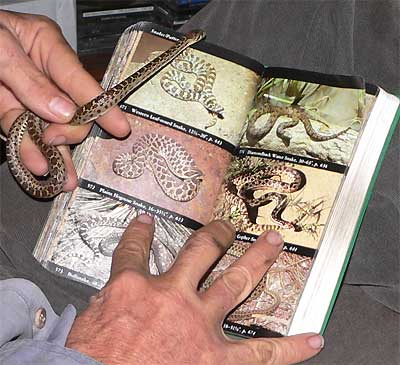
Excerpts from Jim Conrad's
Naturalist Newsletter
from the April 24, 2005 Newsletter issued from the Sierra Nevada foothills
somewhat east of Placerville, California, USA
BUCK'S GOPHER SNAKE
Wednesday morning my upslope friend Buck came for a visit on his motorcycle. Buck is 84 years old and his motorcycle is a '67 Honda, and that day he was carrying a sack with a small snake in it.
Buck said he thought he had a gopher snake, but that the more he looked at it the more he saw a rattlesnake's pattern, and recently he'd confused a rattlesnake for a safe snake, but rattlesnakes have flat heads and this one didn't, but...
A look at the snake's head convinced me that it wasn't a rattler. The eyes of pit vipers have elliptic pupils (cat eyes, like the cross section of a convex lens standing on its edge), and this snake's pupils were round. Also there were no pits between the nostrils and the eyes (the pits are heat- sensitive, used for locating warm-blooded prey), and there were no bulging poison glands behind the eyes giving the head a triangular shape (or flat head, in Buck's terms) so there was no way for this to be a rattler or other pit viper.
It was indeed a gopher snake, the subspecies known as the Pacific Gopher Snake, PITUOPHIS MELANOLEUCUS ssp CATENIFER. Gopher snakes are famed for their rodent- eating talents and you can see for yourself how similar they are to rattlers. A gopher snake is shown at www.backyardnature.net/n/a/gopher-s.htm; a Western Rattler at www.backyardnature.net/n/a/w-rattle.htm
My Audubon field guide reports fifteen gopher-snake subspecies, and most of those subspecies at one time or another have been thought of as full species. Louisiana Pine Snakes, Bullsnakes, Great Basin Gopher Snakes and our Pacific Gopher Snake are all the same species, just different, interbreeding, blending together subspecies. In appearance they range from nearly entirely black ones to those striped like garter snakes, to gray-blotchy or brown-blotchy ones, to some that are white with dark red blotches! You can just imagine how many herpetological publications and symposia it took before they were all finally accepted as under one name.
It happens that I needed a picture of someone using a field guide making an identification, so Buck and my friend Fred took a neat picture of my hands holding our gopher snake right next to the field guide page bearing its picture. You can see that below:
